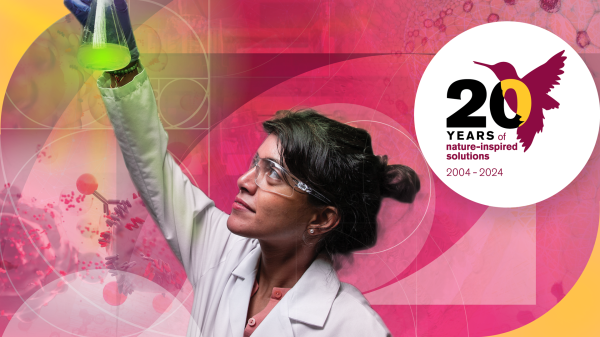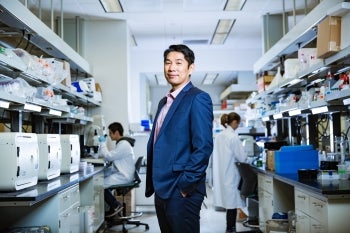Harnessing nature’s code for data storage

Researchers at Arizona State University, along with their international partners, have developed a breakthrough method that greatly enhances the capacity and efficiency of DNA storage. This method introduces "epi-bits," which are akin to movable type in a printing press, capable of being rearranged on a universal DNA template. Graphic by Jason Drees
As the digital world expands, scientists are exploring DNA’s remarkable capacity to store data, converting this ancient molecule into a next-gen information archive.
Since the 1980s, DNA has been considered an ideal medium for data storage due to its extraordinary density and stability. DNA can store up to a billion times more information in the same volume compared with traditional silicon-based storage, and encoded sequences can last for centuries under the right conditions.
Researchers from Arizona State University and international collaborators have unveiled a method that significantly increases DNA storage capacity and efficiency using "epi-bits," which function like movable type in a printing press and can be arranged on a universal DNA template.
The new approach sidesteps the lengthy and expensive process of synthesizing new DNA, making it a quicker, more cost-effective solution. With DNA’s durability and compact nature, this method has the potential to store vast amounts of data in a minuscule space for long durations, offering a major shift from conventional storage technologies.
“It's encouraging to see that epigenetic principles from biochemistry textbooks and taught in my classroom can be applied seamlessly to DNA data storage applications to solve some of the unmet challenges in this field,” says corresponding author Hao Yan.
Yan is the director of the Biodesign Center for Molecular Design and Biomimetics, a Milton D. Glick Distinguished Professor in the School of Molecular Sciences at ASU and, as an Alexander von Humboldt Research Award winner, is currently a guest at the University of Stuttgart.
The research appears in the current issue of the journal Nature.
Biological flash drive
Early efforts involved synthesizing new strands from scratch, encoding data one nucleotide at a time — making the process slow, costly and impractical for large-scale use. The method described in the new study bypasses these limitations.
Instead of building DNA from scratch, the team uses existing strands, modifying them post synthesis with a process inspired by nature’s own method of regulating gene activity: epigenetic modification.
The technique draws on epigenetics, a natural process where chemical groups are added or removed from DNA to regulate gene expression, thereby determining whether a gene is turned on or off. This regulation affects protein production, which drives essential cellular functions. The researchers adapted this natural mechanism, using it to encode digital information instead of biological instructions.
By adding or removing chemical markers known as methyl groups on specific DNA bases, the researchers create epi-bits — tiny molecular data points that function like binary switches. A methylated base (epi-bit 1) and an unmethylated base (epi-bit 0) serve as the equivalent of the binary code used in computers.
The research team used a method called parallel molecular printing, where a universal DNA strand serves as a base and 700 different DNA segments act as building blocks. Each segment contains a unique pattern of epi-bits that represent digital information. By arranging these segments on the base strand, the researchers encoded around 270,000 bits of data, achieving a rate of 350 bits per reaction. The stored data was then read quickly and accurately using advanced sequencing technology.
“This new approach demonstrates how one can harness molecular mechanisms for innovative data solutions, bridging the fields of biology and digital information,” says Laura Na Liu, a co-author of the new study.
Liu is the director of the 2nd Physics Institute at the University of Stuttgart in Germany and a fellow at the Max Planck Institute for Solid State Research.
Advantages over traditional methods
DNA’s stability and compact nature make it an ideal medium for long-term data storage, capable of addressing the exponential growth of global data demands. The inherent stability of DNA means it can store information for hundreds, if not thousands, of years without degradation, making it a promising candidate for future data centers.
The approach works with existing DNA, using a fixed library of segments that can be dynamically modified, eliminating the need for chemical synthesis. This advancement significantly reduces costs and opens the door to practical, large-scale applications.
The researchers describe this method of storing complex data, including images, as having high fidelity and minimal error rates. Compared with existing DNA data storage approaches, the new technique is faster and more economical.
The epi-bit technology could offer a more sustainable and resource-efficient option compared with traditional electronic storage. As global data demands continue to surge, researchers believe that DNA’s compactness and durability could help mitigate the growing environmental impact of large-scale data storage.
Challenges and future directions
Despite the promise of this method, challenges remain. The complexity of methylation-based encoding and the need for precise control over chemical modifications require sophisticated technologies and methods. Achieving high-fidelity writing and reading is critical, as errors in the methylation process or misalignments could lead to data loss or corruption.
However, the potential benefits of this storage medium, including its compact size, environmental resistance and longevity, could outweigh these challenges. With further development, the technique could pave the way for highly efficient, adaptable data storage solutions.
The researchers envision future applications where DNA storage could be combined with molecular computing systems, enabling data to be stored, processed and even computed within the same medium. This would transform DNA from a mere storage molecule into an active participant in data processing.
Such innovations could open exciting possibilities in synthetic biology, bioinformatics and beyond, integrating data storage seamlessly with biological functions.
More Science and technology

ASU startup Crystal Sonic wins Natcast pitch competition
Crystal Sonic, an Arizona State University startup, won first place and $25,000 at the 2024 Natcast Startup Pitch Competition at the National Semiconductor Technology Center Symposium, or NSTC…

Celebrating '20 Years of Discovery' at ASU’s Biodesign Institute
Editor’s note:The Biodesign Institute at Arizona State University continues to celebrate its landmark 20th anniversary with this fifth installment in its "20 Years of Discovery" series. Each…

Rocket science: Students land opportunity to create inflatable lunar pad for NASA
Editor's note: The ASU AEGIS team won the Best Systems Engineering award — one of two awards given to the six teams that presented at the Las Vegas forum held Nov. 11–12. Sixteen Arizona State…
